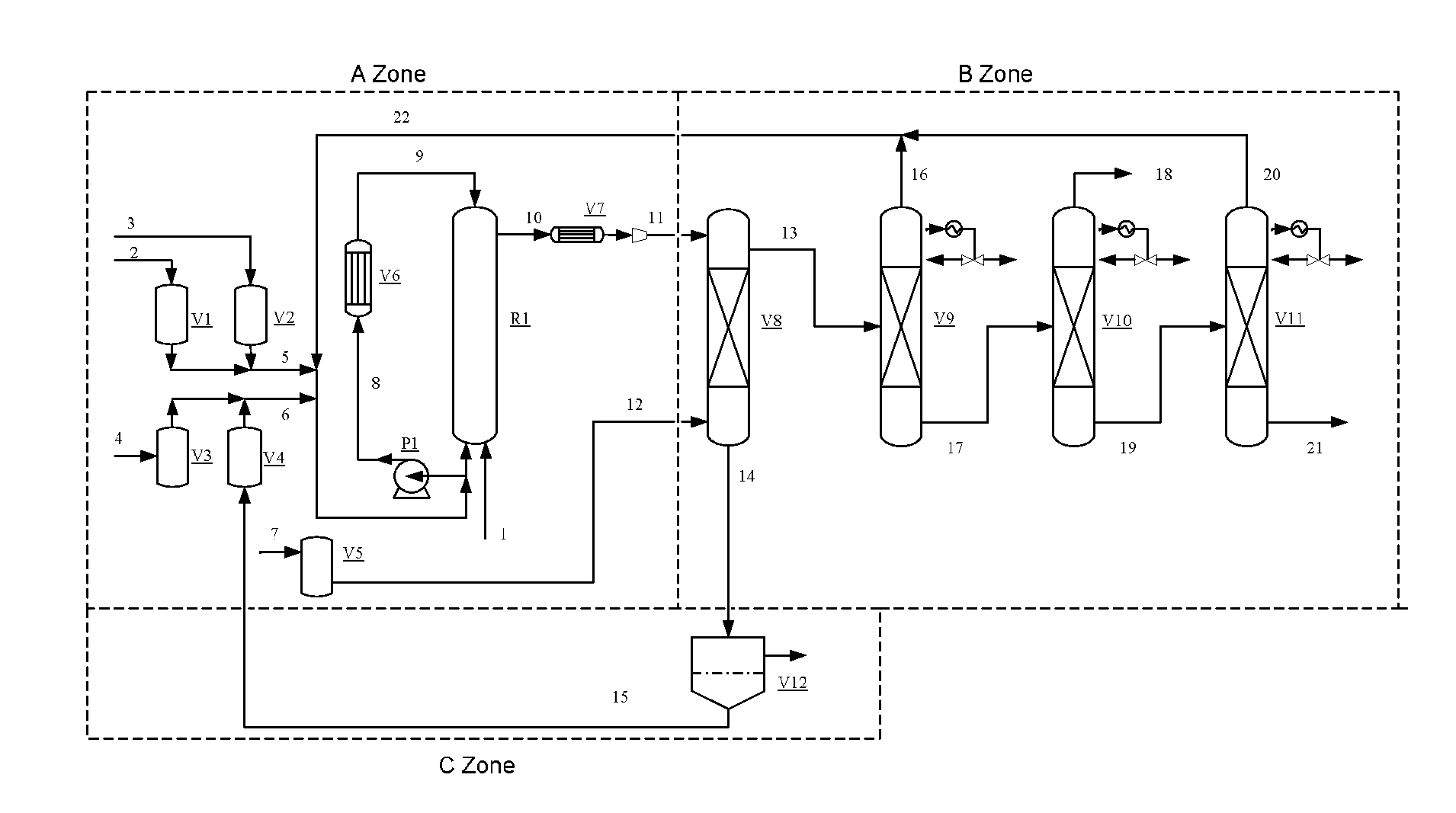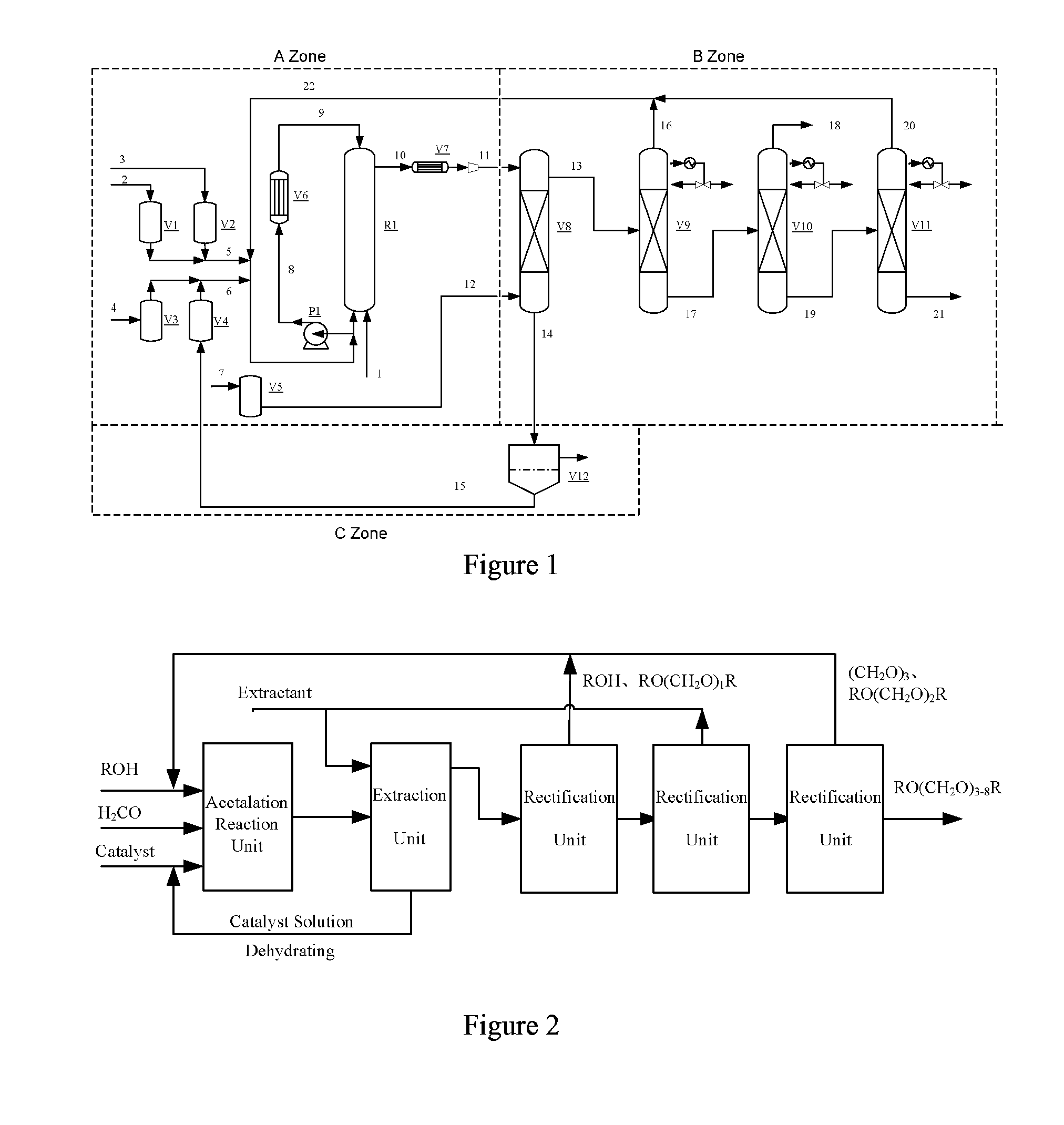System and method for continuously producing polyoxymethylene dialkyl ethers
a technology of dialkyl ether and reaction system, which is applied in the direction of ether preparation, liquid-liquid reaction process, organic chemistry, etc., can solve the problems of high energy consumption, difficult to separate methanol and dmm, and inability to reuse catalysts, etc., to achieve the effect of effective separation of products and easy work up of catalyst solutions
- Summary
- Abstract
- Description
- Claims
- Application Information
AI Technical Summary
Benefits of technology
Problems solved by technology
Method used
Image
Examples
example 1
[0061]In the reaction process shown in FIG. 1, the volume of the reactor R1 is 1000 mL, the reactor R1 is in flow communication with the heat exchanger, and the reaction solution is recycled in the reactor and the heat exchanger.
[0062]The system was purged with high-purity nitrogen to replace air. Ionic liquid catalyst I was fed into the fluidized reaction system. The feeding speed was 1.0 g / h. The feeding was stopped until the catalyst begins to be circulated, so that the concentration of the catalyst was ensured to be not less than 4%. Trioxymethylene with a purity of 98.5 wt %, and the methanol with a purity of 99% were charged under the feeding speed of 15.0 mL / h and 100 mL / h, respectively into the reactor R1 to conduct the reaction. The operating condition of the reactor R1 was controlled at 115-120° C. and 2.5-3.5 MPa.
[0063]The reaction solution is fed into the extraction column V8, and the feeding speed of the extractant benzene is 25 mL / h The heavy phase (i.e., an aqueous ca...
example 2
[0064]The basic process steps and the configuration of the devices were the same as Example 1, except that the ionic liquid II was added as the catalyst, the feeding speed was 0.6 g / h. The feeding was stopped until the catalyst begins to be circulated; the reaction materials were 80 wt % of aqueous formaldehyde solution, and methanol with a purity of 99%, and the feeding speed was 10.8 mL / h and 5.8 mL / h, respectively. The operating condition of the reactor R1 was controlled at 125-130° C., and 3.5-4.0 MPa. The acetalation reaction ran continuously for 100 hours. The results are shown in Table 2.
TABLE 2The pipe-lineDischargeProducts distribution (%)wherespeedCH3O(CH2O)nCH3 n=the sampling point ismL / hbenzenemethanolformaldehydewater123456781117.002.45.119.329.126.211.63.51.90.5001329.552.31.32.70.216.815.27.62.01.00.300144.55.45.52.066.76.70.4000000213.000.300.050.11.259.526.89.82.600Note:the extracted aqueous catalyst solution (14) contains catalyst in 13.3%.
example 3
[0065]The basic process steps and the configuration of the devices as well as the parameters thereof were the same as Example 1, except that toluene was used as the extractant. The reaction ran continuously for 100 hours, resulting in 9.1 mL / h of DMM3-8 product (from pipe-line 21).
PUM
| Property | Measurement | Unit |
|---|---|---|
| pressure | aaaaa | aaaaa |
| temperature | aaaaa | aaaaa |
| temperature | aaaaa | aaaaa |
Abstract
Description
Claims
Application Information
 Login to View More
Login to View More - R&D
- Intellectual Property
- Life Sciences
- Materials
- Tech Scout
- Unparalleled Data Quality
- Higher Quality Content
- 60% Fewer Hallucinations
Browse by: Latest US Patents, China's latest patents, Technical Efficacy Thesaurus, Application Domain, Technology Topic, Popular Technical Reports.
© 2025 PatSnap. All rights reserved.Legal|Privacy policy|Modern Slavery Act Transparency Statement|Sitemap|About US| Contact US: help@patsnap.com



